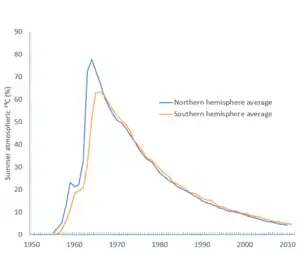WikiJournal of Science
Open access • Publication charge free • Public peer review • Wikipedia-integrated
|
VOLUME 1 (2018)
ISSUE 1
Previous issue
Authors: Mike Christie, et al. , et al.
Radiocarbon dating (also referred to as carbon dating or carbon-14 dating) is a method for determining the age of an object containing organic material by using the properties of radiocarbon, a radioactive isotope of carbon. The method was developed in the late 1940s by Willard Libby, who received the Nobel Prize in Chemistry for his work in 1960. It is based on the fact that radiocarbon (14 Full text | Download doi: 10.15347/WJS/2018.006
Authors: Guy Vandegrift, Joshua Stomel
In 1964 John Stewart Bell made an observation about the behavior of particles separated by macroscopic distances that had puzzled physicists for at least 29 years, when Einstein, Podolsky and Rosen put forth the famous EPR paradox. Bell made certain assumptions leading to an inequality that entangled particles are routinely observed to violate in what are now called Bell test experiments. As an alternative to showing students a "proof" of Bell's inequality, we introduce a card game that is impossible to win. The solitaire version is so simple it can be used to introduce binomial statistics without mentioning physics or Bell's theorem. Things get interesting in the partners' version of the game because Alice and Bob can win, but only if they cheat. We have identified three cheats, and each corresponds to a Bell's theorem "loophole". This gives the instructor an excuse to discuss detector error, causality, and why there is a maximum speed at which information can travel. Full text | Download doi: 10.15347/WJS/2018.005
Authors: Tatiana P. Soares da Costa, Cody J. Hall
Amino acids are an essential building block of all life and are commonly incorporated into extending polypeptide chains to produce proteins. Lysine is one such amino acid and is classified as basic and positively charged at physiological pH due to the presence of an additional amino chemical group on the side chain. Lysine has two main biosynthetic pathways, namely the diaminopimelate and α-aminoadipate pathways, which employ different enzymes and substrates and are found in different organisms. Lysine catabolism occurs through one of several pathways, the most common of which is the saccharopine pathway. Lysine plays several roles in humans, most importantly proteinogenesis, but also in the crosslinking of collagen polypeptides, uptake of essential mineral nutrients, and in the production of carnitine, which is key in fatty acid metabolism. Furthermore, lysine is often involved in histone modifications, and thus, impacts the epigenome. Due to the importance of lysine in several biological processes, a lack of lysine can lead to several disease states including; defective connective tissues, impaired fatty acid metabolism, anaemia, and systemic protein-energy deficiency. In juxtaposition to this, an overabundance of lysine, caused by ineffective catabolism, can cause severe neurological issues. Full text | Download doi: 10.15347/WJS/2018.004
Authors: Shih Chieh Chang, Saumya Bajaj, K. George Chandy
Stichodactyla toxin (ShK) is a 35-residue basic peptide from the sea anemone Stichodactyla helianthus that blocks a number of potassium channels. An analogue of ShK called ShK-186 or Dalazatide is in human trials as a therapeutic for autoimmune diseases. Full text | Download doi: 10.15347/WJS/2018.003
Authors: Boris Tsirelson, et al. , et al.
While modern mathematics use many types of spaces, such as Euclidean spaces, linear spaces, topological spaces, Hilbert spaces, or probability spaces, it does not define the notion of "space" itself. A space consists of selected mathematical objects that are treated as points, and selected relationships between these points. The nature of the points can vary widely: for example, the points can be elements of a set, functions on another space, or subspaces of another space. It is the relationships that define the nature of the space. More precisely, isomorphic spaces are considered identical, where an isomorphism between two spaces is a one-to-one correspondence between their points that preserves the relationships. For example, the relationships between the points of a three-dimensional Euclidean space are uniquely determined by Euclid's axioms, and all three-dimensional Euclidean spaces are considered identical. Topological notions such as continuity have natural definitions in every Euclidean space. However, topology does not distinguish straight lines from curved lines, and the relation between Euclidean and topological spaces is thus "forgetful". Relations of this kind are sketched in Figure 1, and treated in more detail in the Section "Types of spaces". It is not always clear whether a given mathematical object should be considered as a geometric "space", or an algebraic "structure". A general definition of "structure", proposed by Bourbaki, embraces all common types of spaces, provides a general definition of isomorphism, and justifies the transfer of properties between isomorphic structures. Full text | Download doi: 10.15347/WJS/2018.002 Editorial | The aims and scope of WikiJournal of Science
Author: Thomas Shafee, WikiJournal of Science editorial board
WikiJournal of Science is an open access, peer reviewed journal, free of publication charges for its authors. It has Wikipedia-integration as a key feature and aims to encourage and recognise contributions to Wikipedia by academics. It is a sister journal to the established WikiJournal of Medicine, and covers science, technology, engineering and mathematics. This editorial will discuss the current aims and future scope of the journal, as well as the WikiJournal format in general. Full text | Download doi: 10.15347/WJS/2018.001
|
|





